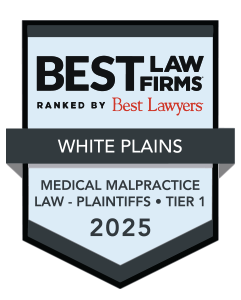New York law allows victims to pursue compensation when a medical provider’s negligence causes injury. Understanding the types of damages available is critical to building a strong case, and a White Plains medical malpractice lawyer can help guide you through the process.
Economic Damages in a Medical Malpractice Case
Economic damages compensate victims for the measurable financial losses caused by malpractice. These damages must be supported by documentation. Common categories of economic damages include:
- Medical expenses: Costs for hospital stays, surgeries, diagnostic tests, and other necessary treatments.
- Future medical care: Ongoing costs for rehabilitation, physical therapy, prescription drugs, or assistive devices.
- Lost income: Wages lost during recovery. Pay stubs, tax returns, and employer records establish the amount.
- Loss of earning capacity: If the malpractice permanently reduces the victim’s ability to work, courts award damages based on expected career trajectory.
- Home modifications: Expenses for ramps, lifts, or other changes when malpractice causes a disabling condition.
- In-home care: Compensation for nursing assistance or home health aides.
Economic damages are the backbone of a malpractice claim because they directly reflect the financial toll of medical negligence.
Non-Economic Damages
Non-economic damages address the human cost of malpractice. These losses cannot be measured by receipts but have life-altering effects. Key categories of non-economic damages include:
- Pain and suffering: Compensation for physical pain caused by the malpractice.
- Emotional distress: Anxiety, depression, post-traumatic stress, or reduced quality of life.
- Loss of consortium: Compensation to spouses for loss of companionship, affection, and intimacy.
- Loss of enjoyment of life: Damages for the inability to participate in activities and hobbies once enjoyed.
- Permanent disfigurement or disability: Recognition of the emotional toll and life changes that accompany visible scars or long-term disability.
New York law does not cap non-economic damages in malpractice cases, unlike many other states. This allows juries to fully compensate victims for the extent of their suffering.
Punitive Damages in New York Malpractice Cases
While rare, New York law allows punitive damages in cases of extreme misconduct. These damages do not compensate the victim but punish the provider for reckless or intentional harm. Examples include:
- Knowingly ignoring test results that reveal a life-threatening condition.
- Altering medical records to cover up a mistake.
- Prescribing medication in dangerous amounts without medical justification.
Punitive damages serve as a deterrent to reckless behavior and send a clear message that patient safety must remain the top priority.
Wrongful Death Damages in Medical Malpractice
When malpractice results in death, New York Estates, Powers & Trusts Law § 5-4.1 allows families to file a wrongful death action. Damages in these cases include:
- Funeral and burial costs
- Medical expenses incurred before death
- Loss of the deceased’s financial support
- Loss of parental guidance for surviving children
- Conscious pain and suffering endured by the patient before passing
New York wrongful death law does not allow families to recover damages for grief or emotional loss. However, the law provides a framework for significant financial recovery when a medical error takes a life.
How Courts Calculate Damages in New York Malpractice Cases
Damages are not awarded randomly. Courts and juries carefully evaluate the evidence to determine a fair figure. Factors considered include:
- Medical records: Documentation of treatment, test results, and hospital notes.
- Expert testimony: Specialists explain how the malpractice caused injury and detail future care needs.
- Employment data: Past income and projected career earnings help establish lost earning capacity.
- Life expectancy tables: Used to calculate long-term damages in cases of permanent injury.
- Daily impact evidence: Testimony from the victim and family members about lifestyle changes and limitations.
An attorney ensures experts present clear and convincing evidence to maximize recovery.
Common Examples of Medical Malpractice Cases and Recoverable Damages
Every malpractice case is unique, but certain categories of damages frequently appear:
- Misdiagnosis leading to advanced illness: Costs of aggressive treatment and diminished life expectancy.
- Surgical errors: Additional surgeries, long recovery periods, and permanent disability.
- Birth injuries: Lifelong care needs, therapy, and special education.
- Anesthesia mistakes: Brain damage requiring full-time nursing assistance.
- Medication errors: Hospital stays, organ damage, or loss of mobility.
Malpractice damages extend far beyond immediate medical bills and the long-term impact on families is profound.
Statute of Limitations and Time Limits in New York Malpractice Cases
Victims of medical malpractice must act quickly to preserve their right to compensation. New York law sets strict filing deadlines under Civil Practice Law and Rules § 214-a. In most cases, a patient has two years and six months from the date of the malpractice to file a lawsuit. However, several important exceptions apply:
- Continuous treatment doctrine: If the negligent provider continues treating the patient for the same condition, the clock starts after treatment ends rather than on the date of the error.
- Foreign object cases: If a surgical tool, sponge, or other object is left inside the patient’s body, victims have one year from the date of discovery—or when it should have been discovered—to file suit.
- Minor victims: Children who suffer malpractice before turning 18 may file within ten years of the malpractice, but the action must still commence within the general time limit once they become adults.
- Wrongful death cases: Families must file within two years of the patient’s death, even if the statute of limitations for malpractice has not yet expired.
Failing to meet these deadlines usually results in the court dismissing the case.
Why Hire an Attorney for a Medical Malpractice Claim
Medical malpractice litigation in New York is highly complex. Victims face strict procedural rules, short filing deadlines, and the need for expert medical testimony. Without legal representation, patients risk losing compensation they deserve. An attorney provides essential advantages, including:
- Mastery of procedural rules: New York requires a certificate of merit from a medical professional before filing a malpractice case. Attorneys ensure all filing requirements are met on time.
- Access to medical experts: Lawyers work with physicians and specialists who can explain how the provider failed to meet the accepted standard of care.
- Thorough investigation: Attorneys gather medical records, depose witnesses, and uncover evidence that patients often cannot access on their own.
- Accurate damage calculation: Lawyers use economists and medical experts to project future medical costs, lost income, and long-term care needs.
- Negotiation skills: Attorneys know how to challenge insurance companies that attempt to minimize payouts.
- Trial experience: If a fair settlement cannot be reached, skilled litigators present the case to a jury and advocate for maximum recovery.
With legal representation, victims stand on equal footing with hospitals, doctors, and insurance carriers that have significant resources.
Contact Us Today
If you or a loved one has suffered harm due to medical negligence, contact Fiedler Deutsch, LLP. We offer free consultations, call (914) 993-0393 or send us a message online.
 Because Relationships Matter
Because Relationships Matter 

















